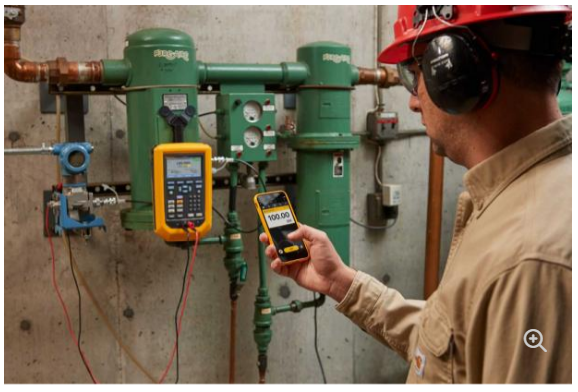
Key features
- Automatic pressure generation and regulation to 300 psi
- Configure procedures for pressure transmitters and switches
- Measure, source, and simulate 4 to 20 mA signals
- Troubleshoot and calibrate HART smart transmitters
- Automatically document test results
Product overview: Fluke 729 Automatic Pressure Calibrator
Portable automatic pressure calibrator simplifies pressure calibration
The Fluke 729 Automatic Pressure Calibrator has been designed specifically with process technicians in mind to simplify the pressure calibration process and provide faster, more accurate test results. Technicians know that calibrating pressure can be a time-consuming task, but the 729 makes it easier than ever with an internal electric pump that provides automatic pressure generation and regulation in an in an easy-to-use, rugged, portable package.
Automatic pressure generation and control
The ideal portable pressure calibrator, the 729 allows you to simply type in a target pressure, and the calibrator will automatically pump to the desired set-point up to 300 psi (20 bar, 2 MPa). Then, internal fine adjustment control automatically stabilizes the pressure at the requested value. You can also fill in a test template and the 729 will automatically pump to and document a multiple-point pressure calibration test at the touch of a button.
The automatic internal fine pressure adjustment can also help compensate for minor leaks in hoses and test setups providing technicians with a stable measurement. No need to manually turn a vernier to compensate for leaks helping to eliminate the hassle of manual pumping and manual fine adjustment of test pressures.
Easy calibration documentation
The Fluke 729 can automatically test multiple pressure test points and automatically document the results. Calibration is as easy as typing in the starting and ending pressure, the number of test points, and the test tolerance. The 729 does the work for you by documenting and flagging out-of-tolerance test results in red on the graphical display for:
- Applied pressure
- Measured mA, mV, or digital PV
- % error for each test point
With Fluke Connect® compatibility, the 729 enables a user to perform remote monitoring using the Fluke Connect mobile app to manage and store pressure measurements and logging events. The app even allows for easy sharing so the whole team can access measurements without needing to be in the facility.
Upload and manage documented calibration results with DPCTrack2™ Calibration Management Software, making it easy to manage your instrumentation, create scheduled tests and reports, and manage calibration data.
HART communication
Built-in HART communication capabilities enable HART transmitter mA adjustments, HART configuration, and the ability to adjust to applied 0% and 100% values. You can also do configuration tasks such as changing a transmitter tag, measurement units, and ranging. Other supported HART commands include setting fixed mA outputs for troubleshooting, read device configuration, and variables and read device diagnostics.
Rugged, portable design
The 729 is tested and warranted to withstand a 1-meter drop test so it is ready for field instrumentation calibration work. With three ranges to choose from, 30 psi (2 bar, 200 kPa), 150 psi (10 bar, 1 MPa) and 300 psi (20 bar, 2 MPa), Fluke 729 Automatic Pressure Calibrators are designed to perform when and where you need them. You can also measure temperature with optional 720RTD probe for performing custody transfer calibrations. A standard semi-rigid carrying case designed for field work, with room in the case to store test hoses, fittings, test leads, and small hand tools means it’s easy to carry everything needed for field pressure calibrations.
Attach one of 50 Fluke 750 Series Pressure Modules to expand the pressure range outside of the internal pump specifications. For greater accuracy and resolution on low pressure calibrations, the Fluke 729 can integrate an external Fluke 750 Series Pressure Module into the test workflow, greatly expanding the calibrators capabilities in low pressure ranges.
